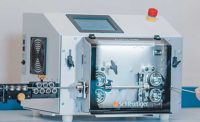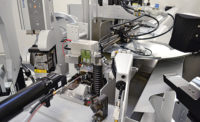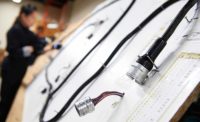Wire harness assembly doesn’t get more complex or safety-critical than in the aerospace industry. A typical harness might contain thousands of wires and hundreds of connectors—all of which must be designed for the utmost reliability and assembled with absolutely no defects.
Small wonder, then, that aerospace manufacturers are constantly investing in the latest technology for wire processing and assembly, as the following case studies illustrate.
Laser System Marks Wires for Mars Lander
On Nov. 26, 2018, the NASA Mars InSight spacecraft started its dramatic descent toward the Martian surface. After separating from the cruise stage, it entered the planet’s upper atmosphere at a height of 80 miles and a speed of 12,300 mph. As it slowed, the probe’s protective aeroshell reached temperatures of 2,700 F. At 36,500 feet and 861 mph, its parachute deployed, slowing it to 134 mph. At 3,600 feet, the spacecraft fired its landing rockets, enabling it to alight on Mars at a gentle 5 mph. At 7:53 p.m., Greenwich Mean Time, mission control received a signal that the spacecraft had successfully touched down on Elysium Planitia, a broad plain that straddles the Martian equator.
InSight (Interior Exploration using Seismic Investigations, Geodesy and Heat Transport) is NASA’s latest Mars lander, which is designed to explore the deep interior of Mars. After landing, the lander will survey the surrounding area and deploy various scientific instruments.
Planned to last for two years, the InSight mission will investigate the interior structure and composition of Mars to learn how a rocky body forms and evolves to become a planet. The mission will also determine the rate of Martian tectonic activity and meteorite impacts.
Lockheed Martin Space Systems was the prime contractor responsible for building the complete spacecraft system. Based on the proven design of NASA’s Mars Phoenix lander, InSight is equipped with two video cameras, a robotic arm, two solar panels (7 feet in diameter), a seismometer, a heat-flow probe and a radio science experiment. In addition, various sensors will measure the planet’s weather and magnetic field variations.
The robotic arm is more than 5 feet, 9 inches long. Its job is to lift the seismometer and heat-flow probe from the deck and place them on the Martian surface. So far, all the instruments have been deployed and are working properly.
Connecting all of InSight’s gear required some seriously reliable wiring with tough, hard-to-process insulation. A laser marking and cutting machine from Spectrum Technologies Ltd. ensured that engineers would be able to easily identify all of the spacecraft’s mission-critical wiring.
Specifically, Spectrum supplied Lockheed with a fully automatic Nova 820 UV laser wire marking system in 2014. This was used in the initial stages of harness production to mark, measure and cut wires to length.
“We may only have played a small part in this interplanetary project, but I and all the team at Spectrum are exceptionally proud and excited to be associated with the Mars InSight program,” says Peter Dickinson, Spectrum’s CEO. “InSight is truly leading-edge, and we look forward with anticipation to seeing what new knowledge it turns up while it explores Mars and its deep interior.”
The Nova 800 product range was designed for complex wire harness assembly applications in the aerospace industry. The heart of the unit is a high pulse-rate, air-cooled, diode-pumped, UV solid-state laser, coupled with a two-axis galvanometer scanning system that directly writes onto the surface of a wire. Optimized fonts ensure maximum mark quality and legibility.
The device complies with all OEM aerospace specifications and international standards, including Boeing Standard D6-36911 and SAE AS 5649 and ASD EN4650 “Wire and Cable Marking Process, UV Laser.”
The system can mark numbers, upper- and lower-case letters in various font sizes, logos, and 1D and 2D machine-readable codes. Each identification mark can contain up to 200 characters.
The device can process all UV-markable wire and cable, including shielded and unshielded, single conductor and multiconductor. It can process wires from 26 to 6 AWG.
The system has been designed for ease of use and maintenance. A large front door provides access to the cable handler to facilitate loading and unloading of wires. Up-and-over side panels provide quick access to the sealed IP4X laser and optical enclosure for maintenance. Alignment of the laser beam to the wire for setup and maintenance is done via a PC in Class 1 laser mode. There are no flash lamps or water filters to change.
A range of wire handling options are available, including powered and unpowered dereelers with controlled pay off and wire tension. A digital optical sensor automatically detects knots, splices and wire ends. An optional feeding system allows up to 32 different wires to be set up and processed under computer control.
A single, motorized coiling pan is standard, but other downstream wire collection devices are available, including a rereeler for continuous production.
Lockheed purchased the machine for more than just the InSight program. The aerospace giant is using the equipment for many other programs, including the wiring produced for NASA’s Orion program.
For more information on laser-based wire marking, cutting and stripping equipment, call Spectrum Technologies at 817-232-2373 or visit www.spectrumtech.com.
Boeing Cuts Production Time by 25 Percent with Skylight on Glass
An astounding 130 miles of wiring go into every new Boeing 747-8 freighter, tucked away overhead and underfoot, from the cockpit to the wheel wells. For Boeing, that translates to thousands of miles of wiring—and tens of thousands of hours of work—each year. To ease this complex task, Boeing uses smart glasses and the Skylight platform from Upskill.
There’s no margin for error in building an airplane. “You can’t pull over if something goes wrong” says Ricky Ramirez, a Boeing electrical technician.
Every Boeing aircraft, from the 737 to the 787 Dreamliner, has multiple configurations, each with its own wiring scheme. In years past, technicians used “phone books” full of diagrams to do their work. Laptops helped, but had the same basic problem: Technicians had to constantly look away from the task at hand to get directions and cross-check diagrams and schematics.
Recently, Boeing’s engineering team discovered a new wearable technology: Glass Enterprise Edition and Skylight enterprise software from Upskill. They began a pilot program, with Skylight replacing those laptops and phone books of paper. Engineers saw improvements right away.
“It was clear, across the board, that it was going to work,” recalls Jason DeStories, R&D engineer at Boeing.
Skylight gives Boeing’s technicians the instructions they need right in their viewfinder. No need to look away or tap a laptop: They can move through multiple prompts with voice commands, the Glass touchpad, and the head tracking interface. A simple voice command like “local search 1-8-6-A” calls up the correct step-by-step schematic for that specific wire.
Voice command is a major improvement over typing commands on a laptop, says Ramirez. “Now you have two hands on the product the whole time,” he explains. “You don’t have to look away. It was a huge time-saver.”
Bar code readers and the Glass cameras help identify and confirm wiring inventory. When extra help is needed, workers turn on Skylight’s “See What I See” video stream and share their view with engineers or other remote experts. Technicians can also look at how-to videos right in their field of view, keeping their hands free to do the work.
With Skylight, Boeing cut its wiring production time by 25 percent and reduced error rates effectively to zero. Boeing calls that kind of improvement a step function change.
“Rather than picking up seconds or minutes, a step function change gives us an opportunity to cut the build time by 25 percent,” says Randall MacPherson, senior manager for Boeing’s Electrical Strategic Fabrication Center. His workers are more efficient, with better workstation ergonomics, and it’s easier for them to share knowledge and bring new workers up to speed.
Now Boeing is looking at ways to use Skylight in other areas of its manufacturing and assembly. “Wearable technology is helping us amplify the power of our workforce,” says MacPherson.
For more information on augmented reality and smart glasses, call Upskill at 703-436-9283 or visit https://upskill.io.







